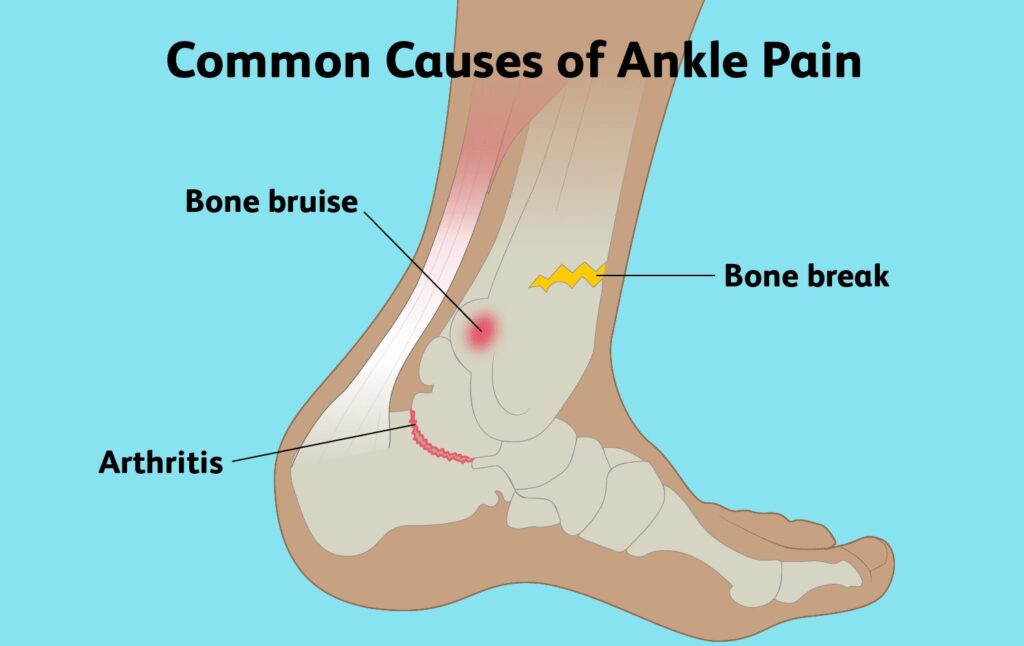PAIN NEAR ANKLE
Ankle is the weight bearer of our body. Ankle pain is caused due to many potential reasons ranging from acute injuries like ankle sprain or fracture, to chronic conditions like ankle arthritis.
Our ankles are part of the musculoskeletal system that support the body’s weight and help us stand, balance and move. The ankle joint is flexible allowing you to point, flex, rotate and move your foot from side to side.
The tibia and fibula bones in lower leg bones come together to meet the foot bone to form the ankle. The bones are connected together by ligaments. A complex structure of tendons, muscles and other soft tissues together allow the foot and ankle to move freely. The ankle is mainly prone to injury due to its complex nature.
Ankle pain and injuries are common among:
- People above the age 65.
- People who play sports or involve in activities such as jumping, side-to-side movements or quick changes in direction.
- People carrying extra weight or are obese.
CAUSE OF ANKLE PAIN
The ankle joint comprises bones, muscles, cartilage, and tissues such as ligaments and tendons. Pain in the ankle can be caused by injury or disease affecting any of these ankle structures.
Some of the common cause of ankle pain are:
- Bursitis: Bursae are fluid-filled sacs that cushion your bones during any movement. Any irritation and inflammation in these sacs leads to bursitis.
- Fractures: An accident or injury can lead to bones to break or fracture ranging from mild to severe. Broken ankles involve bones in any part of the ankle joint causing ankle swelling and pain.
- Sprains: Sprain in ankles are a common cause of ankle pain. An ankle sprain is caused due to ligaments stretch or tear. Sprained or twisted ankles occur due to forceful roll of the ankles out of its normal position.
- Tendonitis: Irritated, inflamed tendons are a soft-tissue injury causing pain and inflammation. Tendons connect muscles to bones and tear easily causing an Achilles tendon rupture. A torn tendon might require surgical repair.
- Bone Bruise: Ankle bone could be bruised from a less severe injury to the bone than a fracture. Ankle bone bruises are common and usually accompanied with ankle sprain. Similar to fracture bone bruises are severely painful and cause swelling.

Ankle pain might be caused due to many diseases, disorders and conditions including:
- Arthritis: Pain and stiffness in the ankle joint can result from arthritis occurring in cartilage that breaks down due to bones rubbing together. Injuries and overuse can also lead to arthritis. People above the age of 65 are more prone to developing arthritis. Several types of arthritis can affect the ankles including rheumatoid arthritis and osteoarthritis.
- Flatfoot: A very low arch or no arch can cause pain and swelling in the ankles and feet. Children are more prone to developing flatfoot, resulting in heel pain.
- Gout: Gout is similar to arthritis resulting from a buildup of uric acid throughout the body. Uric acid is excreted from the body in urine. But, excess uric acid if deposited would lead to formation of crystals that settle in the joints causing painful conditions.
- Infection: Numerous types of infection, such as cellulitis, can cause swelling and pain in the ankle joint. Infection is the bone infection or osteomyelitis might result from a staph infection.
- Peroneal Neuropathy: The nerve runs down the lower leg and branches into: the deep peroneal nerve and the superficial peroneal nerve. The symptoms would differ depending on the position of compression of the nerve. Deep peroneal nerve compression causes ankle pain accompanied with burning or tingling sensations between the two toes of the foot.
- Tumor: Benign or noncancerous tumors of the foot and ankle, like synovial cyst are common, but malignant or cancerous bone tumors, like chondrosarcoma are rare.
SYMPTOM OF ANKLE PAIN
Ankle pain is accompanied with other symptoms including:
- Ankle swelling
- Bruising
- Redness
- Numbness or tingling
- Instability
- Burning pain
- Inability to bear weight on the affected ankle,
- Stiffness and weakness
You should see a podiatrist if:
- Inability to walk comfortably on the affected side of ankle
- Injury causing deformity around the ankle joint
- Ankle pain that occurs even at night or while resting
- Ankle pain persisting beyond a few days
- Inability to bend the ankle
- Swelling in the ankle joint or the calf area
- Signs of an infection, accompanied with fever, redness, and warm skin
DIAGNOSIS OF ANKLE PAIN CAUSES
Podiatrists would diagnose common causes of ankle pain based on medical history, physical examination and X-ray. Other rare conditions would require additional imaging tests and blood tests.
Blood tests would help to diagnose conditions such as rheumatoid arthritis by checking an anti-cyclic citrullinated peptide (anti-CCP) level. This is an indicator for inflammation in the joints.
Ankle pain could also result from fracture. The Ottawa ankle rules are used by emergency room and primary care doctors to rule out an ankle fracture due to an ankle injury.
Other tests such as talar tilt test or squeeze test are also used to diagnose the cause of ankle pain.
TREATMENT OF ANKLE PAIN CAUSE
Treatment of ankle pain would depend entirely on the ankle problem. The podiatrist would recommend the treatment plan based on the cause including:
1. RICE Protocol: It is a common home-based treatment method for ankle pain. It is beneficial in providing relief in musculoskeletal injuries including ankle sprains and ankle tendonitis. It involves 4 essential steps:
- Rest- It involves simply resting the joint and allowing the acute inflammation to subside. Sometimes, it provides relief from mild ankle pain. But in case of severe pain, crutches could be helpful.
Ice– Ice bags or cold gel packs are among most common treatments for ankle pain to reduce swelling and soothe ankle pain.
Compression– Compression bandages such as ACE wrap support and immobilize your ankle joint. Sometimes, excessive compression would lead to sensation of numbness, tingling, increased pain, cooling, or swelling in the affected area of the ankle.
Elevation– Raising your ankle above the level of your heart would initially help reduce swelling after an ankle injury.
2. Physical Therapy: This is helpful in relief from various ankle problems including strains, tendonitis, and after an ankle surgery. Physical therapists would advise rehabilitation exercises to increase ankle muscle strength, regain mobility, minimize stiffness, and prevent chronic ankle problems.
3. Medication: Podiatrist would recommend painkillers along with above therapies for quick relief in pain. NSAIDs are commonly prescribed medications to relieve pain caused by problems such as arthritis, sprains, and tendonitis. For pain caused by severe conditions such as severe fracture, stronger pain medications like opioids may be prescribed for a short period of time. For severe cases of arthritis, cortisone helps reduce inflammation. This is usually injected directly into the ankle joint.
4. Surgery: For certain ankle conditions like ankle fracture surgery is recommended. Arthroscopic ankle debridement, ankle arthrodesis and Ankle arthroplasty (or total ankle replacement) are advised based on the severity of arthritis.
TAKEAWAY
Maintaining good muscle strength and flexibility in the ankle is vital in preventing numerous ankle-related injuries. Once the diagnosis is done, the podiatrist would move forward with a treatment plan. This is a stepwise journey to obtaining the pain relief you deserve.
If you or anyone you know is suffering from ankle pain, our expert providers at Specialty Care Clinics will take care of your health and help you recover.
Call us on (469) 545-9983 to book an appointment with our specialists.

